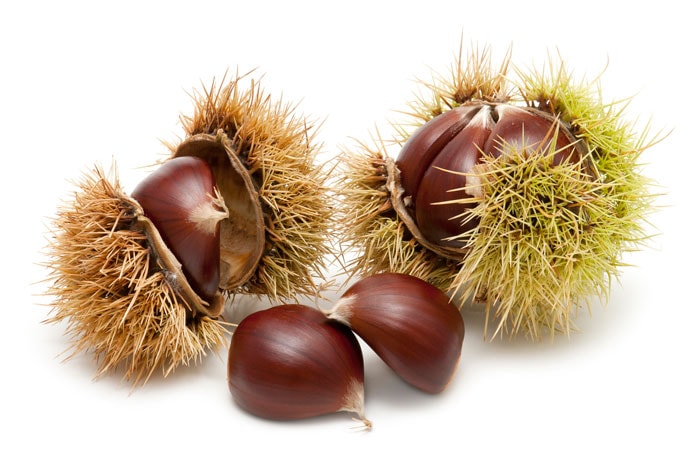
Written By: Sofia Layarda, MPH
Title: Master of Public Health
Alumni: University of California, Berkeley
Last Updated on:

A well-known Christmas song has a line about chestnuts roasting on an open fire. While not many of us still roast fresh chestnuts over an open fire, it is fitting to take a look at this delicacy in time for holiday celebrations. Because chestnuts mature in late autumn, their peak availability runs through December.
Chestnuts are the edible seeds of the sweet chestnut tree. The seeds sit inside a prickly outer shell called the burr, which splits open when ripe. Chestnuts have been consumed in various parts of the world for thousands of years. The trees were once very abundant across the United States, but a disease called the chestnut blight almost wiped them out. Reforestation efforts have brought these trees back in some areas, but the bulk of the chestnuts available in our grocery stores are imported from Italy, Korea, and China.
Table of Contents
10 kernels (approx. 2.5 oz) of peeled, roasted European chestnuts contain:

Chestnuts are a very good source of potassium, which is beneficial in lowering blood pressure. They also contain a good amount of copper, as well as manganese and selenium, which play important roles in the body’s antioxidant and anti-inflammatory reactions. In addition, chestnuts contain Vitamin C (30% DRI in the 2.5 oz serving) as well as B-vitamins and folate.
Despite the “nut” in their name, chestnuts are a lot lower in fat and protein and higher in carbohydrate and water content than other nuts and seeds. In this sense, chestnuts are a lot more like the vegetables you would find in the misted fresh produce display section of the supermarket than the foods common to the dried/bulk section. This should be your first clue to finding fresh chestnuts of good quality. If not stored properly, fresh chestnuts can dry out quickly and get moldy within days.
Fresh chestnuts must be peeled and cooked before using, which is time-consuming. If you don’t have access to a fresh supply, or if you wish to cut down on prep time, you can buy chestnuts that are dried, vacuum-packed, or canned. Vacuum-packed and canned chestnuts are ready to use as is, but dried chestnuts need to be pre-soaked for at least 2 hours or overnight, then cooked in water over medium heat until tender (approximately 15 minutes).
Alumni: University of California, Berkeley – Sofia believes in bringing back fun and pleasure into everyday eating. She loves cooking, and is constantly experimenting with ingredients, creating recipes and trying them out on family and friends. Her latest interest lies in finding realistic and practical ways of environmentally-friendly food/eating habits.
chestnuts, grocery aisle, healthy every month, nuts, seeds